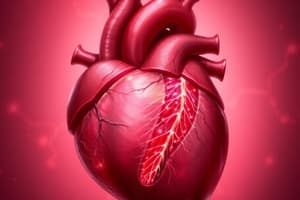Podcast
Questions and Answers
What is the main characteristic of valvular stenosis?
What is the main characteristic of valvular stenosis?
- Valve fails to close completely
- Valve narrows and can't open fully (correct)
- Valve leaflets become enlarged and floppy
- Valve cusps fuse together
In which type of valvular defect does blood regurgitate or leak backward?
In which type of valvular defect does blood regurgitate or leak backward?
- Valvular stenosis
- Inflammation in the heart
- Mitral valve prolapse
- Valvular incompetence/prolapse (correct)
What is the major complication associated with Mitral Valve Stenosis?
What is the major complication associated with Mitral Valve Stenosis?
- Thrombus formation (correct)
- Congestive Heart Failure
- Poor Circulation
- Pulmonary Edema
How does the left atrium respond in Mitral Valve Stenosis?
How does the left atrium respond in Mitral Valve Stenosis?
What is the primary treatment for issues like Mitral Valve Stenosis?
What is the primary treatment for issues like Mitral Valve Stenosis?
Which of the following best describes valvular incompetence?
Which of the following best describes valvular incompetence?
Which organ is most commonly affected by hypertension according to the text?
Which organ is most commonly affected by hypertension according to the text?
What is the primary treatment approach for essential hypertension as per the text?
What is the primary treatment approach for essential hypertension as per the text?
Which type of hypertension is described as uncontrollable, severe, and rapidly progressive in the text?
Which type of hypertension is described as uncontrollable, severe, and rapidly progressive in the text?
What is the most common symptom of early-stage hypertension mentioned in the text?
What is the most common symptom of early-stage hypertension mentioned in the text?
Which diagnostic test is used to measure the size of limbs and blood volume in organs or tissues as per the text?
Which diagnostic test is used to measure the size of limbs and blood volume in organs or tissues as per the text?
What is the most common site for atherosclerosis, a type of peripheral vascular disease, as mentioned in the text?
What is the most common site for atherosclerosis, a type of peripheral vascular disease, as mentioned in the text?
What is a common symptom of pericarditis?
What is a common symptom of pericarditis?
What is the primary effect of fibrous tissue formation in chronic pericarditis?
What is the primary effect of fibrous tissue formation in chronic pericarditis?
What can result from inflammation or infection spreading from adjacent structures in pericarditis?
What can result from inflammation or infection spreading from adjacent structures in pericarditis?
In which age group is prehypertension most likely to occur?
In which age group is prehypertension most likely to occur?
What is the average survival time after diagnosis of Primary Pulmonary Hypertension?
What is the average survival time after diagnosis of Primary Pulmonary Hypertension?
What is the most important indicator for left ventricle resistance and workload in hypertension?
What is the most important indicator for left ventricle resistance and workload in hypertension?
What is the common term for essential hypertension that is of unknown cause?
What is the common term for essential hypertension that is of unknown cause?
What is the primary cause of the thickening of the walls of pulmonary arteries in Primary Pulmonary Hypertension?
What is the primary cause of the thickening of the walls of pulmonary arteries in Primary Pulmonary Hypertension?
Which of the following is a common example of Secondary Pulmonary Hypertension?
Which of the following is a common example of Secondary Pulmonary Hypertension?
How is the diagnosis of Primary Pulmonary Hypertension typically made?
How is the diagnosis of Primary Pulmonary Hypertension typically made?
Which diagnostic test for Primary Pulmonary Hypertension is mentioned to be prone to blood clots?
Which diagnostic test for Primary Pulmonary Hypertension is mentioned to be prone to blood clots?
What symptom is often presented as a result of Primary Pulmonary Hypertension?
What symptom is often presented as a result of Primary Pulmonary Hypertension?
What is the most common valve abnormality in men over 50 years?
What is the most common valve abnormality in men over 50 years?
Which valve replacement involves using tissue from the patient's own fascia?
Which valve replacement involves using tissue from the patient's own fascia?
Which type of endocarditis has an insidious onset with increasing fatigue and anorexia?
Which type of endocarditis has an insidious onset with increasing fatigue and anorexia?
What are common predisposing factors for infective endocarditis?
What are common predisposing factors for infective endocarditis?
Which condition is characterized by inflammation of the pericardial lining?
Which condition is characterized by inflammation of the pericardial lining?
What is a common long-term effect of rheumatic fever?
What is a common long-term effect of rheumatic fever?
What diagnostic test is commonly used for rheumatic fever?
What diagnostic test is commonly used for rheumatic fever?
What are basic effects of infective endocarditis?
What are basic effects of infective endocarditis?
What is the primary etiology of infective endocarditis?
What is the primary etiology of infective endocarditis?
Which valve replacement involves using tissue from a human donor?
Which valve replacement involves using tissue from a human donor?
Flashcards are hidden until you start studying




